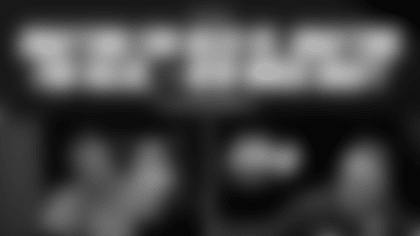The Steelers drafted Le'Veon Bell to run with the football.
It took longer than initially anticipated for Bell to get going, but the Joe Greene Great Performance Award that Bell accepted at season's end as the Steelers' 2013 Rookie of the Year suggested he got there eventually. Further evidence of Bell's arrival could be found in the franchise record he broke, that being Franco Harris' rookie total of 1,235 yards from scrimmage. Bell finished with 1.259.
"Remember, Le'Veon had a week and a half of training camp and three plays in a (preseason) game, and then he got hurt," offensive coordinator Todd Haley observed in December. "He came back in the Minnesota game (on Sept. 29 in London), but up until that he had played three plays in an NFL game, and it was in the preseason.
"He has developed."
Bell knows he has more developing to do, and he is looking forward to being even better in 2014.
"There are a lot of things that I feel I can work on and get better at," he said. "I'm nowhere near where I want to be. There are a lot of things I know I can get better at. I'm going to work hard this offseason and try to get better for next year."
He may just be getting started, but Bell nonetheless has a firm understanding of where he wants to go and how he intends to get there. Especially when the Steelers hand him the ball and ask him to run with it, a process Bell explained in detail:
PRE-SNAP
"I'm always kind of looking at the defense, seeing how the defensive line is slanted. My first read is usually the defensive line. After that, I take a look at the linebackers."
THE HANDOFF
"I don't think about it. We do it so much in practice. We take our steps, clockwork, second nature. The ball is going to be there."
FINDING A HOLE
"My eyes are already on the defense. By the time I get the ball I pretty much already know where I'm going to place it. The defense has moved. The offensive line has moved. By the time you get the ball, you've kind of already made your decision where you're going to go, so you hit it in there.
"Our offense, we run a lot of (inside) zone (blocking schemes) so it's not really a designed hole you go to. It's an area. You kind of pick your hole based on how the defense is moving. There are a lot of things that can go into it.
"It's good running the inside-zone for me. I love it because it gives me an opportunity to be patient."
ATTACKING THE DEFENSE
"Cutbacks usually happen when the defense is being real aggressive. If you hit them play-side a couple of times, that linebacker on the back side, he's trying to get over there to make that play because you've hit them four or five times for 4 or 5 yards. That's when the cutbacks happen, when that backside linebacker is trying to make the play.
"You see that and then you cut it back. That's when the big plays happen."
ENGAGING A DEFENDER
"If he's in front of me in a hole I just lower my shoulder and get what I can. If it's somewhere in open space, I'm going to try to give him a move a lot of the time. I mix it up. Every now and then I might lower my head, let him feel it a little bit, depending on the time of the game. There are a lot of things that go into it, different situations. Usually in the open field I try to get more yards. Usually in a hole I try to fall forward and get what I can."
BALL-SECURITY
"When I'm getting tackled I always make sure I have two hands on the ball. That's something I've been doing since I was younger, tuck it to my chest and make sure I protect it. You don't want to be breaking tackles and then the last guy kind of pops it out. You want to make sure it's protected. I put two hands on it all the time.
"I don't like fumbling. That's the worst feeling in football."





